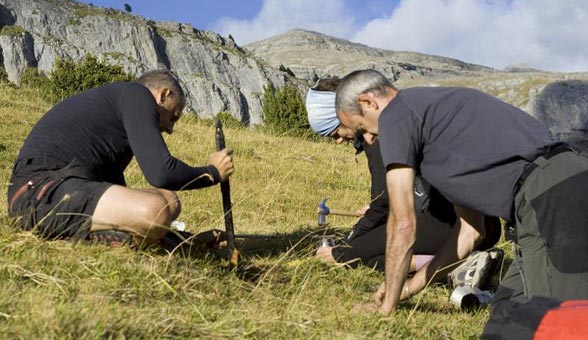NEIKER is studying the impact of climate change on the soil ecosystem

Its purpose is to evaluate the impact of climate change on the ecosystems of the soil by monitoring its microbial properties over time. The research areas are located at altitudes of between 1,500 and 2,600 metres, which provides a broad range of different climate conditions and makes it possible to observe how the altitude affects the properties of the soil and the micro-organisms living in it.
Preliminary results indicate that microbial properties are highly dependent on the physical and chemical properties of the soil on a small scale and on the environmental conditions existing at the moment when the samples are gathered.
To conduct this research, NEIKER-Tecnalia is using the most advanced techniques in the matter of molecular biology, which have revolutionised microbial ecology. Specifically, massive sequencing analyses are being carried out right now; they allow a large number of genes to be sequenced and identified within a short space of time. The genetic sequencing of the subterranean biosphere is seeking to gain a better understanding of the structure and function of the microbial communities across the altitude gradient.
NEIKER-Tecnalia’s Microbial Observatory will contribute towards improving the current understanding of the effects of climate change on soil microbial communities and associated ecological processes. The alpine area where it is located is particularly suitable for a climate change observatory.
Firstly, it is a remote spot relatively isolated from direct anthropogenic impacts, which means that global effects like climate change can be clearly perceived without the interference of more local environmental factors. Secondly, the altitude gradients that exist in the mountains in turn create clearly marked climate gradients within short distances; in other words, different climate conditions can be found at different altitudes.
Micro-organisms adapt more quickly than plants and macro-organisms
Micro-organisms adapt more quickly to changes than plants or other macro-organisms, which means they are ideal bioindicators of the impact of sources of environmental stress on the functioning of ecosystems.
It is very important to have a record of the alterations gradually occurring in the soil ecosystem as a result of climate change to be able to more accurately predict what future scenarios are going to be in store. It is important to stress that the soil is our most important resource; it is the basis of the terrestrial ecosystem and 95% of our food comes directly or indirectly from it.
The role of micro-organisms in relation to the functioning of the soil ecosystem is fundamental. The soil, which has been traditionally regarded as an inanimate item made up of minerals and chemical substances, contains a myriad of micro-organisms that are responsible for many of its vital functions and, consequently, its health. These functions include the decomposition and recycling of nutrients from dead plant and animal tissue, nitrogen fixing, the maintaining of soil structure and the elimination of contaminants.
It can be predicted that, in the long term, climate change will cause the biota of mountain soil to migrate towards higher altitudes in the quest for the optimum bioclimatic environment. The problem is that this migration has a limit, which is the summit of the mountain, beyond which no migration or escape is possible.
http://www.basqueresearch.com/berria_irakurri.asp?Berri_Kod=5336&hizk=I#.VHcWTWfOXTo
Media Contact
All latest news from the category: Ecology, The Environment and Conservation
This complex theme deals primarily with interactions between organisms and the environmental factors that impact them, but to a greater extent between individual inanimate environmental factors.
innovations-report offers informative reports and articles on topics such as climate protection, landscape conservation, ecological systems, wildlife and nature parks and ecosystem efficiency and balance.
Newest articles

A ‘language’ for ML models to predict nanopore properties
A large number of 2D materials like graphene can have nanopores – small holes formed by missing atoms through which foreign substances can pass. The properties of these nanopores dictate many…

Clinically validated, wearable ultrasound patch
… for continuous blood pressure monitoring. A team of researchers at the University of California San Diego has developed a new and improved wearable ultrasound patch for continuous and noninvasive…

A new puzzle piece for string theory research
Dr. Ksenia Fedosova from the Cluster of Excellence Mathematics Münster, along with an international research team, has proven a conjecture in string theory that physicists had proposed regarding certain equations….



